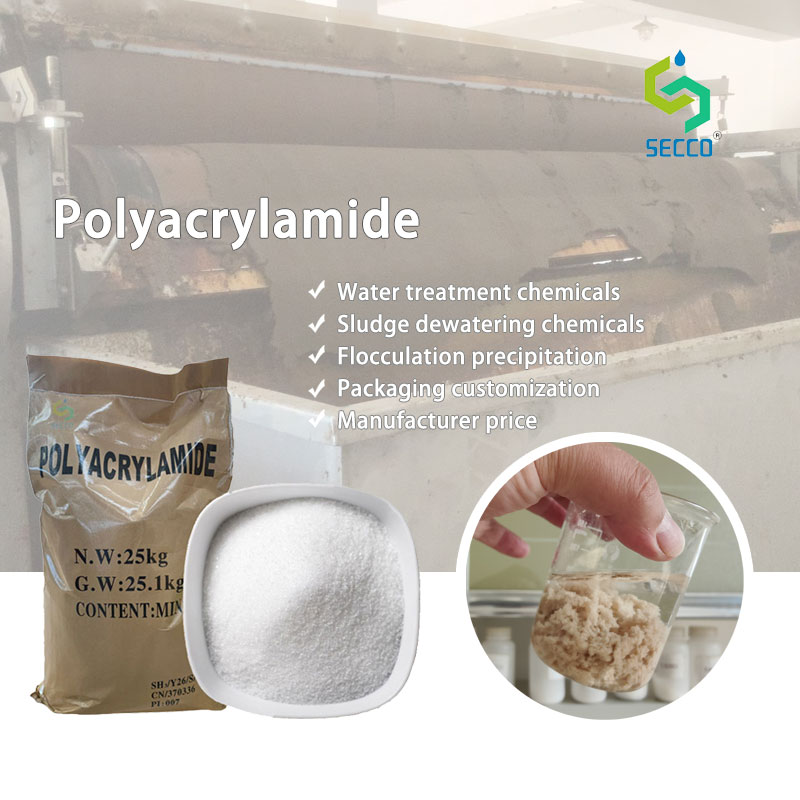Polyacrylamide (PAM)constituit vitam in dewateribus malorum, et seleccio eius super characteristicas malorum, vasa dewateris et conditiones procedere debet. Below is a detailed analysis of the selection principles and performance optimization.

I. Selection Principles
1. Sludge Characteristics Analysis
Content Organic: Highly organic sludge (e.g., municipal sludge) is typically negatively charged and requires cationic PAM (CPAM). Inorganic rich sludge (e.g. industrial sludge) may use anionic (APAM) or non-ionic PAM (NPAM).
Sludge Source:
Municipal Sludge: High organic content, hydrophilic—requires high-charge-density CPAM.
Industrial Sludge (e.g., electroplating, papermaking): Estimat metallos gravos aut inorganicos—laboratorium testi necesse est.
Valor pH:
Acidic (pH < 7): Prefere CPAM non-ionic aut low-charge.
Alkaline (pH > 7): CPAM aut APAM alta carga optima sit.
2. Selection Ionic Type
Cationic PAM (CPAM): Neutralizat negativas charges on sludge colloids, compress the double layer and bridges flocs (used in ~90% of municipal sludge dewatering).
Anionic PAM (APAM): Pontes longos catenas formant, suitable for inorganic sludge or combined with metal salts (e.g. PAC).
Non-ionic PAM (NPAM): Uter in nube neutrale/weakly acidico sed minus communa.
3. Molecular Weight (MW) & Charge Densitate
Molecular Weight:
High MW (12M+ Da): Forms dense, large flocs—ideal for centrifuges & - Cinderella presses.
Low MW (6-8M Da): Better for plate-and-frame filters (avoids clogging clothes).
Charge Densitate:
High charge (20-40%): For highly organic, dispersed sludge.
Low charge (5-10%): For inorganic sludge or pre-conditioning.
4. Matching Dewatering Equipment
Centrifuge: densitate medium-high charge, medium-high MW CPAM for fast flocculation.
Belt Filter Press: High MW, medium-high charge CPAM for shear resistant flocks.
Plate-and-Frame Filter: Low MW, low charge CPAM/APAM to prevent clogging.
5. Solubilitate & Preparation
Dissolutio: 0.1-0.3% concentratione, temperatura aquae ≤60°C (degradatione preventat).
Velocitate missae: 50-200 rpm (fregae catena avoidit).
II. Performance Evaluation Metrics
Dewatering Efficiency
Content of Moisture: Optimal PAM reduces sludge from 98% to 60-75%.
Gravitas Cake: Sublimes libis uniformis opus est; The centrifuges require high solids.
Propietates flores
Size: Ideal floc diameter 1-5 mm (too large traps water; too small causes loss).
Fortitudo: Vera resistentiam (critical for centrifuges).
Consumption Chemical & Costa
Dosage Typica: 2-5 kg PAM per tonnam sicca (optimizata via jar tests).
Qualitate filtrae
Turbidity (NTU) should be < 50 ut minimaret reluctionem cargam.
III. Common Issues & Optimization
Filter Cloth Sticking: Caused by excessive PAM or high MW—reduce dosage or switch to low-viscosity PAM.
Floccus infirmus: crescere densitatem cargae aut adjuste pH a 6-8.
Chemical Waste: Use gradient dosing (low charge first, then high charge).
IV. Processus seleccionis Experimental
Lab Test (Jar Test): Screen ionic type, observe floc formation & - settling.
Test Pilot: Simulate full-scale equipment, optimize MW & - dosage.
Validatio agri: Track dewatering rate, chemical cost & The operational efficiency.
V. Case Studies
Municipal WWTP: CPAM (12M Da, 30% charge) reduces moisture from 98% to 65%, costing $5-8 per ton dry sludge.
Textile Sludge: APAM + FeCl ₃ humilitatem reducit in < 70%.
conclusion
Praecepta PAM significantem magnificat dewatering efficabilitatem sludge et reducit emissiones. Field adjustments based on lab tests and equipment parameters are essential for optimal performance.
Si volueritis ad produktos nostros aut habere quaestiones, implete formam inferiorem, quaeso. We will contact you immediately after receiving it. Thank you for your choice.